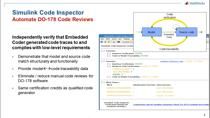How to Perform Back-to-Back Testing in Simulink
Create and run a back-to-back test, which is also known as an equivalence test, using Simulink Test™. Compare the results of normal simulations with the generated code results from software-in-the-loop, processor-in-the-loop, or hardware-in-the-loop simulations. Test systems using recommended practices in standards such as ISO® 26262 and DO-254 with back-to-back testing.
Published: 16 Mar 2022





